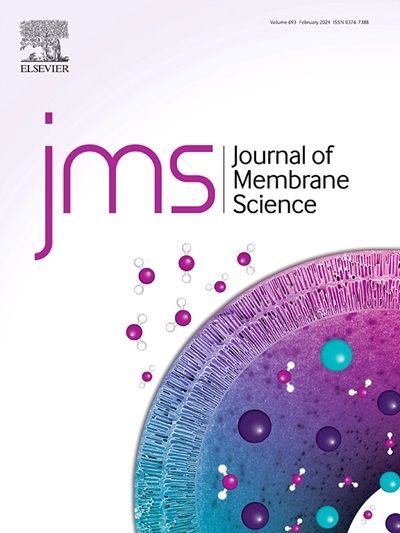Enantiomeric separation of chiral hyper-crosslinked polymer based nanotube membranes
IF 8.4
1区 工程技术
Q1 ENGINEERING, CHEMICAL
引用次数: 0
Abstract
The separation of racemic mixtures remains a great challenge due to the similar physicochemical properties of enantiomers in an achiral environment. Currently, membrane-based separations often face a trade-off between permeability and enantioselectivity. In this study, a uniquely fibrous nanotube membrane, derived from a chiral hyper-crosslinked polymer (CHCP), was constructed and used to separate racemates, motivated by the need for more efficient and scalable separation methods. The results show that such the CHCP-based nanotube membrane exhibits a 2–4 orders of magnitude increase in flux compared to conventional chiral separation membranes and a ca. one order of magnitude improvement relative to GO-based membranes, while maintaining the superior enantioselectivity. This can be attributed to the CHCP-based nanotube that is rich in the micropore and mesopore, thereby resulting in the ultimate membrane that is characteristic of the hierarchically porous structure and the high porosity. Moreover, this membrane displays a great stability, which offers a significant potential for scalable and continuous operations. Experimental studies, combined with density functional theory calculations, substantiate that this membrane follows the retarded transport mechanism, having a great promise in resolving the inherent trade-off. Our findings suggest that this CHCP-based nanotube can find applications in various fields, e.g., separation, catalysis, etc., due to its intrinsic porosity, good processability and ease of synthesis and modifiability.

求助全文
约1分钟内获得全文
求助全文
来源期刊

Journal of Membrane Science
工程技术-高分子科学
CiteScore
17.10
自引率
17.90%
发文量
1031
审稿时长
2.5 months
期刊介绍:
The Journal of Membrane Science is a publication that focuses on membrane systems and is aimed at academic and industrial chemists, chemical engineers, materials scientists, and membranologists. It publishes original research and reviews on various aspects of membrane transport, membrane formation/structure, fouling, module/process design, and processes/applications. The journal primarily focuses on the structure, function, and performance of non-biological membranes but also includes papers that relate to biological membranes. The Journal of Membrane Science publishes Full Text Papers, State-of-the-Art Reviews, Letters to the Editor, and Perspectives.
 求助内容:
求助内容: 应助结果提醒方式:
应助结果提醒方式:


